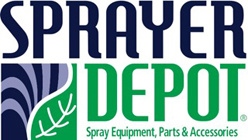 The team here at Sprayer Depot is joining the nation in observance of National Farm Safety and Health Week (September 21-27, 2014) by sharing some essential tips for sprayer safety. According to Allan Vyhnalek, UNL extension educator, in The Banner-Press, “Farming ranks behind mining with the second highest number of disabling and fatal incidents annually.” So we’re joining the campaign to help bring awareness and share safety tips that can help curb this statistic.
The team here at Sprayer Depot is joining the nation in observance of National Farm Safety and Health Week (September 21-27, 2014) by sharing some essential tips for sprayer safety. According to Allan Vyhnalek, UNL extension educator, in The Banner-Press, “Farming ranks behind mining with the second highest number of disabling and fatal incidents annually.” So we’re joining the campaign to help bring awareness and share safety tips that can help curb this statistic.
As for the sprayer itself, here’s a little pop quiz for you:
Sprayer calibration includes which of the following?
a) checking strainers b) checking lines c) checking pumps d) all of the above
Too easy? If you guessed (d) all of the above, you’re correct. Of course, there’s a lot more to sprayer calibration that we’ve covered in previous posts. So let’s stick to three pillars of sprayer safety – filling the sprayer, using the sprayer and cleaning the sprayer.
Filling the sprayer
If you’re using water to fill the sprayer tank, consider the following:
- Make sure that the end of the filling hose is positioned 4” or more above the sprayer’s filling hole.
- Don’t leave the sprayer unattended while you fill it up. This will help avoid overflow or other spillage.
When filling the sprayer tank with a chemical based substance, use these precautions:
- Avoid using the same spot every time you handle concentrated chemicals when filling the sprayer tank. That way, if there are minor spills you’ll benefit from an active soil breakdown. You also won’t have to worry about issues from transporting a full tank of solution through environmentally protected areas.
- A shovel and plastic bag can be used to pick up any spillage on the ground.
Using the sprayer / protect the environment and yourself
- Consider decorating the front of your rig with a wind streamer that will help show you which way the wind is blowing and its likely force.
- Plan ahead for wind changes and, as always, keep an eye on the weather forecast.
- Never attempt any repairs with liquid in the spray tank.
- Avoid over-spraying. It can put your crops at risk, and it poses a hazard. Plus it’s just wasteful.
Cleaning the sprayer inside and out
Of course, we recommend following the manufacturer’s recommendation for cleaning your sprayer inside and out, but here are some general guidelines that can help as well. Cleaning should happen on a daily basis. If you’ve calibrated your sprayer correctly, chances are there is very little remaining in the tank after you finish spraying, which is all the better.
- Dilute the leftover liquid and then spray it over an area that complies with approved use and in a manner that avoids exceeding max dosage. Diluted 10x with water and sprayed over a just treated area often meets requirements.
- If you have a dedicated rinsing tank mounted on your rig, it makes the process quick and easy for cleaning in the field.
- For many of our readers who don’t have a dedicated tank, flush the inside of the tank with an equivalent amount of 10% of the tank size. Repeat twice making sure that all the valves are activated.
- Take care to ensure to follow local rules for disposal, which often means avoiding ditches, drains and sewage.
- Use a high pressure hose to rinse the exterior of the rig, paying attention to those areas that get more contamination like the back of the rig/tank, wheels and boom, if applicable.
If you have time, the National Education Center for Agricultural Safety is offering a weeklong webinar series on a variety of health and safety concerns that serve as a great reminder. After all we can’t be too careful.

.png?width=280&name=SameDayShippingGuarantee-New%20(1).png)



